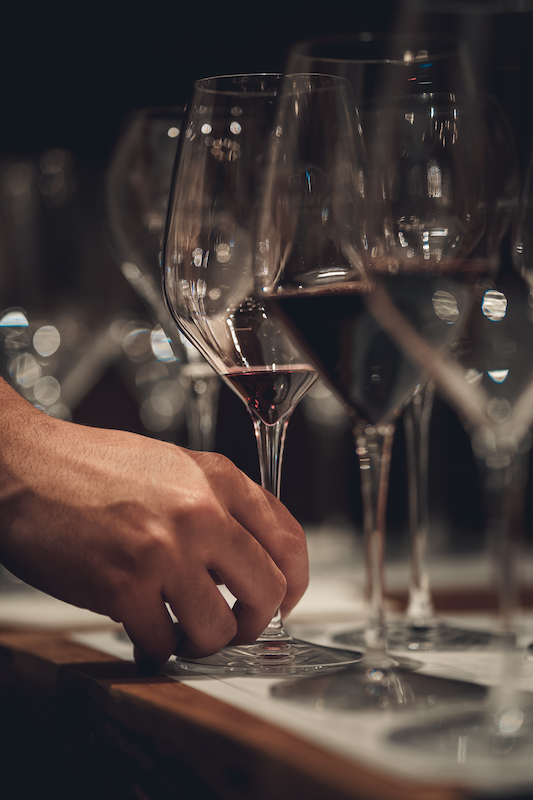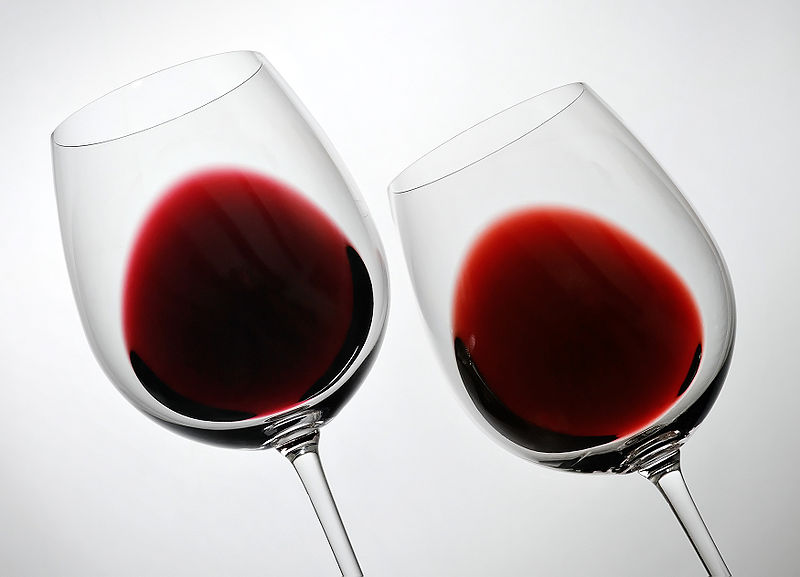 |
Morgain Twain-Peterson stands among the 152 acres of field
blend vines planted by Sen. George Hearst in 1888 in Sonoma Valley.
The Bedrock Wine Co. and his father Joel Peterson,
with Once and Future Wines, now make wines
from the ancient vines that were saved from removal in 2004.
(John Burgess/ Press Democrat) |
Clawing at the sky like gnarled bursts of lightning, the 130-year-old grapevines at Bedrock Vineyard in Sonoma are pillars of survival. There are nearly 30 varieties in this vineyard — burly, twisted limbs pruned goblet-style.
They look like trees in an arthritic pygmy forest. Bedrock Vineyard was planted in 1888 and today is meticulously cared for by winemaker Morgan Twain-Peterson and his father, winemaker Joel Peterson.
The 35-acre “field blend” vineyard contains zinfandel, alicante bouchet,
mourvedre, carignane, tempranillo and
petite sirah, as well as more obscure varieties, such as peloursin, mondeuse, negrette, serine and more, many of which are combined to produce Twain-Peterson’s award-winning wines.
These are some of Sonoma County’s oldest vines. But the story behind them is sometimes muddied with myth.
Some say they were planted by Italian winemakers. Others believe they were planted haphazardly, because there are so many varieties in a single vineyard. But in fact, these vines — sometimes encompassing up to 50 varieties in a single vineyard — were planted with great deliberation and foresight. And that foresight is still paying off today, according to John Olney, winemaker at Ridge Vineyards in Dry Creek Valley.
“The proof is in the pudding when it comes to field blends,” Olney said. ”People were deliberate in choosing the grapes they did because it’s clear they complement each other.”
But how did so many varieties come to be in one vineyard?
The answer is rooted in the crisis that nearly ended grape growing in
Sonoma County for good.
Devastation hits
These intermingled varieties — recognized as field blends — were no accident or haphazard experiment.
“Field-blend vineyards came out of a concerted, organized effort to produce higher-quality, well-balanced wines in the 1880s,” said Twain-Peterson, winemaker and owner of Bedrock Wine Co. in Sonoma. “It all started with phylloxera.”
 |
Vines planted in 1888 in the 152-acre Bedrock field blend
vineyard in the Sonoma Valley: Mataro.
(John Burgess/The Press Democrat) |
In 1873, grape phylloxera — a destructive, sap-sucking insect that feasts on the roots of certain Vitis grapevine species — was officially documented in California, in a vineyard 2 miles north of the town of Sonoma. By the 1880s, phylloxera had quickly spread from Sonoma County to vineyards across the state, decimating every vineyard in its path.
Thousands of diseased vines were ripped out in California, leaving empty fields across the landscape. Bedrock Vineyard was first planted in 1854, but like every vineyard in the state, it, too, was wiped out by the scourge.
Faced with a potential death knell for California’s burgeoning commercial grape industry, state legislators went back to the basics to find a way forward for grape growers.
They established the Board of State Viticultural Commissioners, a collaborative of scientists, academics, winemakers and nurserymen who hopefully could solve the phylloxera crisis, set standards for grape imports and improve wine quality overall.
The board and its chief executive viticultural officer, Charles Wetmore, worked with growers and nurserymen to test 200 grape varieties to determine which vines would perform best, given the state’s weather and soil conditions.
They found they could control phylloxera by grafting imported grapevines onto American Vitis rootstock known as St. George. Now, the viticultural board could provide science-backed guidance to growers on which grape varieties to plant.
“Phylloxera really forced growers to wipe the slate clean and pull out vines that made no sense in California,” Olney said. “What we ended up with are these diversely planted vineyards that continue to produce extremely well-balanced
wines. Field blends are the silver lining of phylloxera.”
Dividends continue
Not only that, the solution the board came up with more than a century ago still has value today in another sense, as grape growers look for stability in a climate that is growing hotter and drier.
At Ridge’s Geyserville vineyard, the “Old Patch” is comprised of vines more than 130 years old. At the winery’s Lytton Springs vineyard in
Dry Creek Valley, there are centenarian vines. In both locations, zinfandel vines are intermixed, or “interplanted,” with carignane, petite sirah, mataro (mourvedre) and other grapes, which are used to produce Ridge’s highly regarded wines.
“
Zinfandel grapes produce a lot of sugar, typically at the expense of acidity,” Olney said. “Carignane is the opposite. It adds acidity, so when it’s blended with zinfandel it keeps the wine fresh and focused, with flavors more in the red fruit spectrum. Carignane is really important grape for us. It’s going to be even more so as the climate gets warmer.”
While climate change and rising temperatures are a significant concern to most winemakers, Olney said, Ridge’s old vines are faring a lot better than he thought they would in the drought.
“It’s pretty amazing,” Olney said.
“Old vines have deep root systems, which give them easier access to water. Ours are also head-trained so the grape clusters grow in a dappled-sunlight environment. Grapes are like us — when they’re outside all day, they like to have a sun hat. The canopy of a head-trained vine provides that shade.”
Field blends
 |
Will Bucklin with a Grenache vine that is believed to have been
planed in the 1880s, in his dry-farmed vineyard in September 2021.
(Robbi Pengelly / Sonoma Index-Tribune) |
At the historic Old Hill Ranch in Glen Ellen, winemaker and grape grower Will Bucklin admitted he’s concerned about water. “The vines are probably faring a lot better than I give them credit for, but there has definitely been a lot of attrition due to the drought and then the heat,” Bucklin said. “I’m still dry farming (farming without irrigation), but I’m concerned I’m going to have to install irrigation next year.”
Founded in 1852 when William McPherson Hill purchased the property from Gen. Vallejo, Old Hill Ranch is now farmed and managed by Bucklin, whose mother and stepfather, Anne and Otto Teller, purchased the ranch in the 1980s. Today, 30 old-vine grape varieties share one vineyard, and it was only until a few years ago that Bucklin could properly identify every vine.
In fact, his Anatomy of a Field Blend map has become something of a
wine industry wonder, with its intricate matrix of colored squares that represent every varietal in the vineyard. Among them, you’ll find tannat, trousseau, zinfandel, French colombard, petite sirah, mourvèdre, lenoir and others, including two varieties native to the French Alps, according to their DNA.
“My guess is that some French guy brought them over in his pocket,” Bucklin said. “As for the rest of the vineyard, I have my own theories about why they planted so many different kinds of grapes.”
Bucklin said field blends help farmers to hedge their bets against weather impacts and pest pressures. Having more varieties in the vineyard is like taking out an insurance policy against nature.
“It’s also about creating more balanced
wines,” he said. “For me, a lot of that is achieved through cofermentation.”
While modern wine blends are often produced by combining two or more finished wines together before bottling, field blend wines are typically made by harvesting all the varieties at once and co-fermenting them at one time — like a traditional French Châteauneuf-du-Pâpe blend. But this doesn’t mean winemakers of yore were trying to save time by cutting corners. There is evidence that cofermented grapes may affect the color intensity and phenolics, or aromas, of a finished wine.
For Bucklin, old-vine field blends are “incredibly compelling.” He said he’s fallen for them “hook, line and sinker.”
“I get kind of philosophical about it because I project what the vines need,” Bucklin said. “In many ways, the old vines are self-regulating at this stage. They don’t require as much labor because they don’t have as much vigor, and they produce less fruit so you don’t have to thin the clusters. “It’s like when you’re a kid, you need a lot of management. When you’re an adult, you just figure things out.”
 GB Crane 2019 Disciples Proprietary Red Napa Valley
GB Crane 2019 Disciples Proprietary Red Napa Valley


















































 Carte Blanche 2019 Cabernet Sauvignon “Beckstoffer” Oakville Napa Valley
Carte Blanche 2019 Cabernet Sauvignon “Beckstoffer” Oakville Napa Valley







